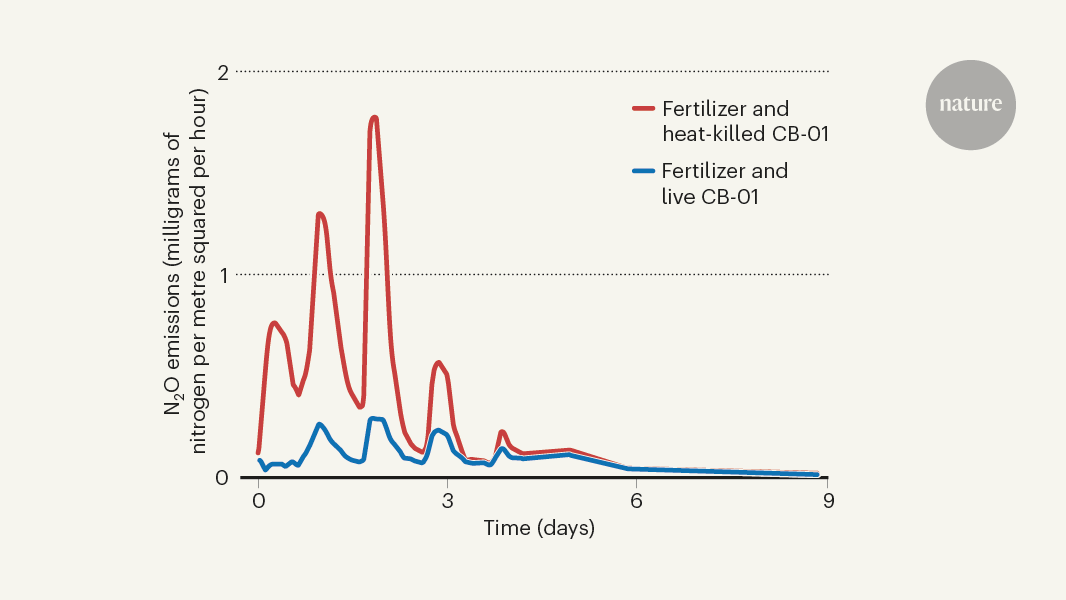insight - Computational Biology - # Bacteria-Mediated Mitigation of Greenhouse Gas Emissions from Nitrogen Fertilizers
Innovative Bacteria-Based Approach to Reduce Nitrous Oxide Emissions from Nitrogen Fertilizer Application in Agriculture
Core Concepts
Introducing nitrogen-hungry bacteria to farm soil can effectively curb nitrous oxide emissions associated with nitrogen fertilizer application.
Abstract
The article discusses an innovative solution to address the issue of greenhouse gas emissions, particularly nitrous oxide (N2O), which is associated with the application of nitrogen-containing fertilizers in agriculture. The researchers report that by introducing nitrogen-hungry bacteria to farm soil, they were able to effectively reduce the emissions of nitrous oxide, a potent greenhouse gas.
The key highlights and insights from the article are:
Climate change is a pressing global challenge, and the research community is actively seeking innovative solutions to lower emissions of climate-warming gases.
Nitrous oxide (N2O), also known as laughing gas, is a significant contributor to greenhouse gas emissions, and it is associated with the application of nitrogen-containing fertilizers in agriculture.
The researchers, Hiis et al., have developed a solution that involves adding nitrogen-hungry bacteria to farm soil, which can effectively curb the emissions of nitrous oxide.
This bacteria-based approach provides a promising avenue to mitigate the environmental impact of nitrogen fertilizer application, which is a crucial aspect of modern agriculture.
The findings of this study contribute to the ongoing efforts to develop sustainable and environmentally-friendly agricultural practices that can help address the challenges of climate change.
Nitrogen-hungry bacteria added to farm soil curb greenhouse-gas emissions
Stats
As the consequences of climate change become increasingly clear1,2, the global research community is being challenged to deliver innovative solutions that lower emissions of climate-warming gases.
Quotes
No relevant quotes found.
Key Insights Distilled From
by Guang He at www.nature.com 05-29-2024
https://www.nature.com/articles/d41586-024-01363-3
Deeper Inquiries
How can this bacteria-based approach be scaled up and implemented across different agricultural regions and crop types?
To scale up this bacteria-based approach, collaboration between researchers, policymakers, and farmers is crucial. Research institutions can conduct field trials in various agricultural regions to assess the effectiveness of the bacteria on different crop types. Once proven successful, extension services can educate farmers on the benefits of using these nitrogen-hungry bacteria and provide training on application methods. Additionally, partnerships with agricultural input suppliers can ensure the availability of these bacteria as a commercial product for widespread adoption. Tailoring the approach to suit specific crop requirements and soil conditions in different regions will be essential for successful implementation.
What are the potential trade-offs or unintended consequences of introducing these nitrogen-hungry bacteria to farm soil, and how can they be addressed?
Introducing nitrogen-hungry bacteria to farm soil may have potential trade-offs or unintended consequences. One concern is the displacement of native soil microbes, which could disrupt the soil ecosystem. This could lead to a decrease in soil fertility or changes in nutrient cycling processes. To address this, thorough research should be conducted to understand the interactions between the introduced bacteria and native soil microbes. Monitoring soil health indicators over time can help detect any negative impacts and allow for timely intervention. Additionally, promoting crop rotation and diverse cover cropping can help maintain soil biodiversity and minimize the risk of unintended consequences.
How can this innovative solution be integrated with other sustainable agricultural practices, such as precision farming or regenerative agriculture, to further enhance its environmental impact?
Integrating this innovative solution with other sustainable agricultural practices can amplify its environmental impact. Precision farming techniques, such as variable rate application of fertilizers based on soil nutrient levels, can optimize the use of nitrogen-containing fertilizers in conjunction with the nitrogen-hungry bacteria. This can reduce overall nitrogen inputs and minimize the potential for nitrous oxide emissions. Furthermore, incorporating regenerative agriculture practices like minimal tillage and agroforestry can improve soil structure and enhance the resilience of the soil microbiome, including the introduced bacteria. By combining these approaches, farmers can achieve a holistic and sustainable farming system that maximizes environmental benefits while maintaining productivity.
0
